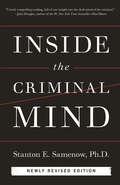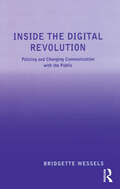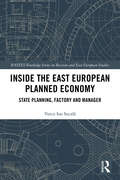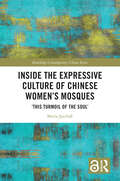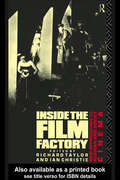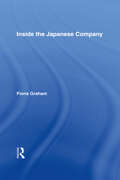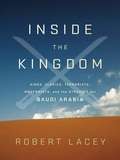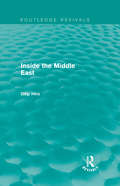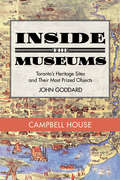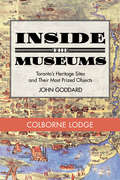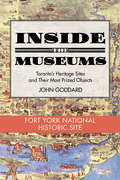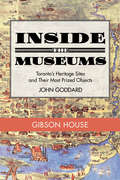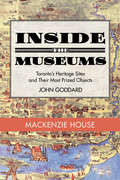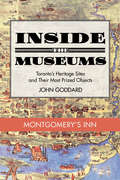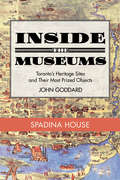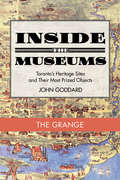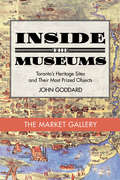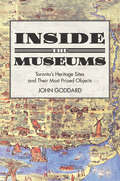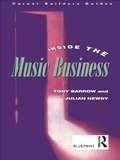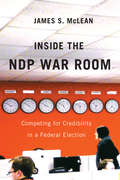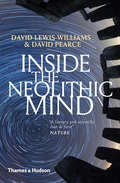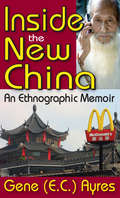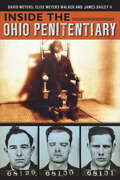- Table View
- List View
Inside the Criminal Mind: Revised and Updated Edition
by Stanton SamenowLong-held myths defining the sources of and cures for crime are shattered in this ground-breaking book--and a chilling profile of today's criminal emerges.
Inside the Digital Revolution: Policing and Changing Communication with the Public
by Bridgette WesselsIn this work, Bridgette Wessels offers a unique insight into the ways in which core public institutions and powerful organizations develop digital communications and services within the public realm. The book draws on her ethnographic research with the London Metropolitan Police Service during their engagement in an innovative project to improve communication with the public using digital technology. As one of the largest, most advanced and highly respected police services in the world, working in a socially, culturally and demographically complex city, the Metropolitan Police Service offers a highly revealing case study of technology and the human processes which it is designed to serve. The ethnographic research is used to develop a new theoretical and conceptual framework for understanding the relationship between social action and technological change, addressing the way in which technology is socially shaped and culturally informed. The book also discusses the role of ethnography as a tool for researching complex multi-perspective, multi-sited networks of the innovation of digital technologies as forms of communication in late modern western society.
Inside the East European Planned Economy: State Planning, Factory and Manager (BASEES/Routledge Series on Russian and East European Studies)
by Voicu Ion SucalaThis book puts forward a new perspective on the planned economies of communist Eastern Europe, demonstrating in detail how economic practice in such countries was shaped by the interplay among planners, managers and Party apparatchiks. Based on extensive original research, including interviews with former employees of industrial enterprises, the book argues that shortages, chronic over-capacities and erroneous planning decisions were present from the very beginning, rather than the consequences of later plan mistakes. They were the natural outcome of a profound conflict between leaders’ attempt to adapt the basic laws of economics to their ideology and interests, and the requirements for rational bureaucracy of an increasingly sophisticated economy. The book discusses the evolution of and debates about the planned economy, considers the practice of plan development and implementation, and provides very detailed examples of how the planned economy actually worked at the level of the factory, at the point where plans and managers interacted with workers and production.
Inside the Expressive Culture of Chinese Women's Mosques: ‘This Turmoil of the Soul’ (ISSN)
by Maria JaschokThis book presents a multi-voice narrative of the history and significance of current contestations over the increasing prominence of expressive piety in Hui Muslim women’s mosques in central China. By drawing on a ‘Song Book’ of chants, collected from the tradition of women’s mosques, as context it reveals just how the increasing prominence of female voices has given rise to considerable misgivings among senior religious leaders over the potential destabilization of orthodox Islamic gendered practices. Providing a historical introduction to the place and function of Islamic chants, jingge and zansheng, the book gives a conceptual framing of female silence, sound, and agency in local translations of Confucian and Islamic precepts, and women’s personal accounts of the role played by traditional and modern soundscapes in transmitting and celebrating Islamic knowledge and faith. As a study of women's soundscapes and the significance of legitimacy, ambiguities, and implications of female sound, this book will be of considerable interest to students and scholars of Chinese society and culture, gender studies, cultural anthropology, and Islam.
Inside the Film Factory: New Approaches to Russian and Soviet Cinema (Soviet Cinema Ser.)
by Richard Taylor Ian ChristieThis is the first collection to be inspired and informed by the new films and archival material that glasnost and perestroika have revealed, and the new methodological approaches that are developing in tandem. Film critics and historians from Britain, America, France and the USSR attempt the vital task of scrutinising Soviet film, and re-examining the Cold War assumptions of traditional historiography.Whereas most books on Soviet giants have glorified the directorial giants of the `golden age' of the 1920s, Inside the Film Factory also recognises the achievements of popular cinema from the pre-Revolutionary period through to the 1930s and beyond. It also evaluates the impact of Western cinema on the early experimenters of montage, Russian science fiction's influence on film-making, and the long-suppressed history of Soviet Yiddish productions. Alongside the new perspectives and source material on the much-mythologised figures of Kuleshov and Medvedkin, the book provides the first extended accounts in English of the important but neglected careers of directors Yakov Protazanov and Boris Barnet.
Inside the Japanese Company
by Fiona GrahamGraham explores the attitudes of Japanese employees towards their work, their company and on related issues. Based on extensive original research inside a Japanese insurance company (C-Life), which subsequently went bankrupt, the book shows that attitudes towards lifetime employment, company loyalty and the other characteristics of Japanese working life, which are often portrayed in stereotype form in the West, are in fact more complicated than is at first apparent.
Inside the Kingdom
by Robert LaceySaudi Arabia is a country defined by paradox: it sits atop some of the richest oil deposits in the world, and yet the country's roiling disaffection produced sixteen of the nineteen 9/11 hijackers. It is a modern state, driven by contemporary technology, and yet its powerful religious establishment would have its customs and practices rolled back to match those of the Prophet Muhammed over a thousand years ago. In a world where events in the Middle East continue to have geopolitical consequences far beyond the region's boundaries, an understanding of this complex nation is essential. With Inside the Kingdom, British journalist and bestselling author Robert Lacey has given us one of the most penetrating and insightful looks at Saudi Arabia ever produced. More than twenty years after he first moved to the country to write about the Saudis at the end of the oil boom, Lacey has returned to find out how the consequences of the boom produced a society at war with itself. Filled with stories told by a broad range of Saudis, from high princes and ambassadors to men and women on the street, Inside the Kingdom is in many ways the story of the Saudis in their own words.
Inside the Middle East (Routledge Revivals)
by Dilip HiroFirst published in 1982, Inside the Middle East is a definitive study of the region. It provides a clear, concise description of the complex social, political and economic life of the Middle East. Beginning with an outline of the birth and growth of Islam in the Arabian Peninsula and the history of Israel and the Jews since 1020 B.C., the book is split in to five geographical and thematic parts. This thorough analysis in particular examines the forces at work within the Arab world, the domestic politics and economy of Israel and the state’s relationship with the West and the Soviet Bloc, and the relationship between the Arabs and the West since the Ottoman Empire. Dilip Hiro concludes with an overall analysis of the past in social, economic and political terms and considers the various possibilities for the future of the Middle East. Containing an unprecedented wealth of information and insight, this fascinating work presents a comprehensive understanding of the world’s richest and most volatile region. It remains of great relevance to scholars and students of Middle Eastern politics and history.
Inside the Museum — Campbell House
by John GoddardInside the Museums views Toronto’s heritage museums for the first time as a single community — linked by events, personalities, and function. In this special excerpt we visit Campbell House, 160 Queen Street West, at the northwest corner with University Avenue, where judge Sir William Campbell (the judge of William Lyon Mackenzie’s trial), built his dream home in 1822. John Goddard takes us on a detailed tour of the house, providing fascinating historical background and insight.
Inside the Museum — Colborne Lodge
by John GoddardInside the Museums views Toronto's heritage museums for the first time as a single community - linked by events, personalities, and function. In this special excerpt we visit Colborne Lodge, well known to visitors to Toronto's High Park. The home of prolific architect, surveyor, and engineer John Howard, as a museum, Colborne Lodge stands out for its original paintings and domestic gadgets. John Goddard takes us on a detailed tour, providing fascinating historical background and insight.
Inside the Museum — Fort York National Historic Site
by John GoddardInside the Museums views Toronto’s heritage museums for the first time as a single community — linked by events, personalities, and function. In this special excerpt we visit one of the jewels in Toronto’s historical crown: Fort York. This fort was the famous site of the Battle of York in 1813 and was founded in 1793 as a military outpost; it served as a barracks as recently as the First World War and is one of the city’s leading tourist attractions. John Goddard takes us on a detailed tour, providing fascinating historical background and insight.
Inside the Museum — Gibson House
by John GoddardInside the Museums views Toronto’s heritage museums for the first time as a single community — linked by events, personalities, and function. In this special excerpt we visit Gibson House, between Sheppard and Finch Avenues, where David Gibson, a leader of the 1838 Rebellion of Upper Canada, lived in this house built in 1851 on his York Township farm. John Goddard takes us on a detailed tour of the house, providing fascinating historical background and insight.
Inside the Museum — Mackenzie House
by John GoddardInside the Museums views Toronto’s heritage museums for the first time as a single community — linked by events, personalities, and function. In this special excerpt we visit Mackenzie House, the grey-brick townhouse, steps from modern Yonge-Dundas Square and the Toronto Eaton Centre, where the firebrand rebel publisher lived from 1859 till his death in 1861; his family moved out in 1871. John Goddard takes us on a detailed tour of the house, providing fascinating historical background and insight.
Inside the Museum — Montgomery's Inn
by John GoddardInside the Museums views Toronto’s heritage museums for the first time as a single community — linked by events, personalities, and function. In this special excerpt we visit Montgomery’s Inn, on Dundas Street West in present-day Etobicoke. For twenty-five years, beginning in 1830, the hard-working Irish immigrant Thomas Montgomery presided over the place, providing food and lodging to travellers, and creating a social hub for the surrounding area. The inn is not to be confused with (John) Montgomery’s Tavern on Yonge Street, rebel headquarters of the 1837 Rebellion. John Goddard takes us on a detailed tour, providing fascinating historical background and insight.
Inside the Museum — Spadina House
by John GoddardInside the Museums views Toronto’s heritage museums for the first time as a single community — linked by events, personalities, and function. In this special excerpt we visit Spadina House on Davenport Hill, less renowned than its ornate but much later neighbour, Casa Loma, and first erected by landowner and politician Dr. William Baldwin in 1818. John Goddard takes us on a detailed tour, providing fascinating historical background and insight.
Inside the Museum — The Grange
by John GoddardInside the Museums views Toronto’s heritage museums for the first time as a single community — linked by events, personalities, and function. In this special excerpt we visit the well-known Grange at 317 Dundas Street West, near the Art Gallery of Ontario. More than any other house in Toronto, The Grange, built in 1817, testifies to the years when a tiny, colonial elite connected by blood and marriage — the Family Compact — dominated the government and judiciary. The Grange was home to the Boultons. On the Family Compact tree compiled by critic William Lyon Mackenzie, patriarch D’Arcy Boulton Sr. ranked No. 1. John Goddard takes us on a detailed tour of the house, providing fascinating historical background and insight.
Inside the Museum — The Market Gallery
by John GoddardInside the Museums views Toronto’s heritage museums for the first time as a single community — linked by events, personalities, and function. In this special excerpt we visit The Market Gallery at 95 Front Street East — the upper floor of the famous St. Lawrence Market. Walk into the market’s interior and look back carefully, and you clearly see an earlier building. It is the remains of Toronto’s first purpose-built City Hall. John Goddard takes us on a detailed tour, providing fascinating historical background and insight.
Inside the Museum — Toronto's First Post Office
by John GoddardInside the Museums views Toronto’s heritage museums for the first time as a single community — linked by events, personalities, and function. In this special excerpt we visit Toronto’s first post office at 260 Adelaide Street East, a handsome red-brick building still flying the Union Jack, and built in 1834. John Goddard takes us on a detailed tour of the house, providing fascinating historical background and insight.
Inside the Museums: Toronto's Heritage Sites and their Most Prized Objects
by John GoddardHeritage Toronto Book Award — Shortlisted, Non-Fiction Book Illuminates Toronto’s early history through its small heritage museums. A portrait of William Lyon Mackenzie stares from a mural at Queen subway station, his face as round and orange as a wheel of cheese. He served as Toronto’s first mayor, led the Upper Canada Rebellion of 1837, and was grandfather to William Lyon Mackenzie King, Canada’s tenth prime minister, whose own orange-pink visage graces the Canadian fifty-dollar bill. Three blocks from the station, Mackenzie died in the upstairs bedroom of a house now open as a heritage museum, part of a network of such homes and sites from early Toronto. Inside the Museums tells their stories. It explains why Eliza Gibson risked her life to save a clock, reveals the appalling instructions that Robert Baldwin left in his will, and examines how the career of postmaster James Scott Howard shattered on the most baseless of innuendos at one of the most highly charged moments in the city’s history.
Inside the Music Business
by Julian Newby Tony BarrowThis book is a comprehensive guide to a career in the music industry. Offering advice as to how to get into the business, it explains the main features of a wide range of jobs, such as management, production, promotion and merchandise through to the working lives of recording artists and session musicians.
Inside the NDP War Room
by James S. McleanThe federal election campaign of 2005-06 offered the usual mix of lofty rhetoric, competing interests, and skullduggery. Nonetheless, this campaign laid the foundation for a major shift in Canadian politics, bringing the Conservative Party to power and changing the balance of opposition parties. Inside the NDP War Room takes readers behind the scenes to investigate the nature of credibility in the complex communicative game of election campaigns. James McLean considers the ways in which the idea of credibility is used to explain how messages are crafted and articulated, how journalists are implicated, and what the Canadian public needs to know about what is at stake in the competition for votes. He talks to insiders about their communication practices and strategies, and reflects upon the grand narratives and small opportunistic moments brought before the Canadian public when power is up for grabs. A vivid, first-hand account of campaign strategizing, Inside the NDP War Room offers insights into the NDP breakthroughs of 2011, the full meaning of Quebec's "orange wave," and the future of a party preparing for a new reality.
Inside the NDP War Room: Competing for Credibility in a Federal Election
by James S. McLeanThe federal election campaign of 2005-06 offered the usual mix of lofty rhetoric, competing interests, and skullduggery. Nonetheless, this campaign laid the foundation for a major shift in Canadian politics, bringing the Conservative Party to power and changing the balance of opposition parties. Inside the NDP War Room takes readers behind the scenes to investigate the nature of credibility in the complex communicative game of election campaigns. James McLean considers the ways in which the idea of credibility is used to explain how messages are crafted and articulated, how journalists are implicated, and what the Canadian public needs to know about what is at stake in the competition for votes. He talks to insiders about their communication practices and strategies, and reflects upon the grand narratives and small opportunistic moments brought before the Canadian public when power is up for grabs. A vivid, first-hand account of campaign strategizing, Inside the NDP War Room offers insights into the NDP breakthroughs of 2011, the full meaning of Quebec's "orange wave," and the future of a party preparing for a new reality.
Inside the Neolithic Mind: Consciousness, Cosmos, and the Realm of the Gods
by David Lewis-Williams David PearceAn exploration of how brain structure and cultural content interacted in the Neolithic period 10,000 years ago to produce unique life patterns and belief systems. What do the headless figures found in the famous paintings at Catalhoyuk in Turkey have in common with the monumental tombs at Newgrange and Knowth in Ireland? How can the concepts of "birth," "death," and "wild" cast light on the archaeological enigma of the domestication of cattle? What generated the revolutionary social change that ended the Upper Palaeolithic? David Lewis-Williams's previous book, The Mind in the Cave, dealt with the remarkable Upper Palaeolithic paintings, carvings, and engravings of western Europe. Here Dr. Lewis-Williams and David Pearce examine the intricate web of belief, myth, and society in the succeeding Neolithic period, arguably the most significant turning point in all human history, when agriculture became a way of life and the fractious society that we know today was born. The authors focus on two contrasting times and places: the beginnings in the Near East, with its mud-brick and stone houses each piled on top of the ruins of another, and western Europe, with its massive stone monuments more ancient than the Egyptian pyramids. They argue that neurological patterns hardwired into the brain help explain the art and society that Neolithic people produced. Drawing on the latest research, the authors skillfully link material on human consciousness, imagery, and religious concepts to propose provocative new theories about the causes of an ancient revolution in cosmology and the origins of social complexity. In doing so they create a fascinating neurological bridge to the mysterious thought-lives of the past and reveal the essence of a momentous period in human history. 100 illustrations, 20 in color.
Inside the New China: An Ethnographic Memoir
by Gene AyresChina is no longer a Third World country. It is now the world's fastest growing economy. Even after the 2008 Olympics, this fact may come as a shock to many Americans, who continue to think that the Chinese still march around in brown uniforms with red stars on their caps arresting dissidents for wearing capitalist Levis. China has at last count, more than half a billion cell phone users. Indeed, the Chinese are not only the world's leading users of mobile phones, but also the leading suppliers. No Chinese student goes without one and even a donkey cart driver chatting away on a mobile is not an uncommon sight.China's educated New Generation is possibly the most highly motivated force since the post-World War II generation in America. The young people of China are the next wave of a flourishing Chinese middle class now estimated as 13.5 % of the population, and expected to be 600 million strong by 2015, according toBusiness Week. These young people want to drive cars like ours, live in houses like ours, own condos near the beach, wear designer clothes, and carry cell phones, iPods, camcorders, digital cameras, and MP3 players, just like Americans. Tens of millions already do.During a thirty-month stay in Chinabetween 2004 and 2007, Ayres was presented to soldiers straight out of boot camp, toasted by military generals and governors, invited to parties with local leaders as a ""foreign expert and dignitary,"" and begged to counsel dissidents and the lovelorn. He rode buses jammed with peasants hoping that they would actually be paid at the end of the month. He dickered with farmers in open markets and street vendors desperate to make ends meet. He dealt with smooth, savvy merchants in upscale department stores; and debated policy with Communist Party bosses. This revised paperback edition of the author's earlier work, A Billion to One, is a vivid, intimate account of China as it is today.
Inside the Ohio Penetentiary (Landmarks)
by David Meyers Elise Meyers Walker James Dailey IIExplore one of history&’s most notorious maximum-security prisons through these tales of mayhem and madness. As &“animal factories&” go, the Ohio Penitentiary was one of the worst. For 150 years, it housed some of the most dangerous criminals in the United States, including murderers, madmen and mobsters. Peer in on America&’s first vampire, accused of sucking his victims&’ blood five years before Bram Stoker&’s fictional villain was even born; peek into the cage of the original Prison Demon; and witness the daring escape of John Hunt Morgan&’s band of Confederate prisoners.
